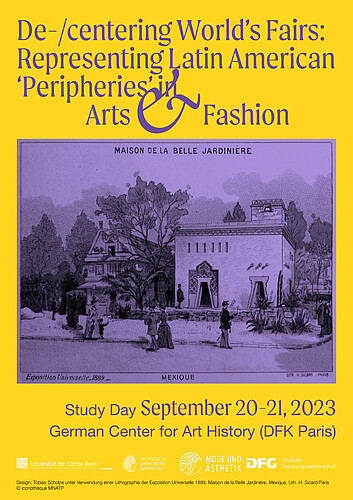De-/centering World’s Fairs: Representing Latin American ‘Peripheries’ in Arts and Fashion
Study Day
September 20-21, 2023
German Center for Art History (DFK Paris)
Study Day Program with Abstracts
The world’s fairs of the nineteenth and early twentieth centuries gave rise to significant impulses in the histories of art and fashion. From the very beginning – and this is particularly true for the five expositions universelles held in Paris between 1855 and 1900 – both were fixed components of nations’ self-presentations at the world’s fairs. Diverse artistic genres and artistic conceptions, as well as fashion, clothing, and textiles played a leading role in the construction of national, cultural, or ethnic identities.
However, both art and fashion experienced a form of globalization at the world’s fairs. Knowledge about the world arose there synthetically by means of an encyclopedic-didactic accumulation of artworks, things and objects, precisely because it was seen and experienced by way of arts and artifacts from the whole world. Objects and nations were turned into the signifiers of a narrative – imagined and presented as coherent – of technological progress, colonial expansion, artistic and fashion innovations.
It was especially the city of Paris that was acknowledged as the 19th-century capital of art and fashion world-wide. The city also attracted many artists and designers from all over the world who searched for being trained and work in Paris and served an intense transcultural artistic and conceptual exchange. Paris thus became a hub for such globalized discourses on art and fashions and joined perspectives from ‚centers’ and ‘peripheries’ alike. The ‘peripheric’ (colonial) states were meant to stand in contrast to the (colonizing) countries of the Global North that organized the fairs thus defining the exhibition style, with ethnographica and handicrafts presented as traditional and ‘authentic’ and contrasting with the ‘fine art’ departments, including oil painting and sculpture. The conjunction of colonizing and colonized nations
at nineteenth and early twentieth-century world’s fairs presents a dichotomy, and it is precisely here that Latin America in particular had an ambivalent role. On the one hand, the majority of Latin American states had themselves been independent since around 1821 and pursued representation as modern nations exhibiting ‘modern’ painting and sculpture. On the other hand, they often embodied the role of the ‘exotic other’ and displayed folklore, handicrafts and ethnographica, not least as a tourism strategy. Styles and genres such as costumbrismo, historical Indigenism, or historicism were to be debated in this context. A critical art history of world’s fairs should therefore engage with these inherent post-/colonial interdependencies. There has not yet been any systematic examination of the role of the staging of arts and fashions of ‘peripheral’ Latin American re/presentations at the international and world’s fairs, in order to establish a comprehensive analysis of the art, exhibition practices, and media. The study day aims to reflect through new and critical research perspectives the role of art and fashion in the context of the world’s fairs and seeks to open up a discussion in Art History and Fashion Studies by approaching the “entangled histories” (Conrad/Randeria) of the world’s fairs against the backdrop of colonialism, imperialism, and globalization.
The conference seeks to discuss a variety of art historical perspectives and to engage with aspects, case studies or theoretical discussion, such as:
The ambivalent role of Latin American states in the context of the (Paris) world’s fairs between their representation as modern nations and their permanent coloniality (colonialidad) as well as self-exoticization.
The artistic and curatorial strategies used by the representatives of (post)colonial or ‚peripheral’ states in Latin America when representing themselves or being represented by European artists and curators.
The role assumed by the arts, visual media, handicrafts, artifacts, textiles and fashion in the framework of national representations at world’s fair and their global and colonial entanglements.
- The implicit and explicit concepts of temporality inherent to the constructions of modernity and tradition within the framework of world’s fairs.
The study day is organized by the DFG-funded research project “A Critical Art History of International and World Expositions – Decentering Fashion and Modernities,” namely Alexandra Karentzos, Elena Nustrini, Miriam Oesterreich, and Lizzy Rys.
PROGRAM
September 20, 2023
6.00 p.m.
Welcome
Prof. Dr. Alexandra Karentzos (Technische Universität Darmstadt) Prof. Dr. Miriam Oesterreich (Universität der Künste Berlin)
Elena Nustrini (Universität der Künste Berlin)
Lizzy Rys (Technische Universität Darmstadt)
6.30 p.m.
Keynote lecture
À la mode: The Paris 1900 exhibition and modern fashion discourses
Prof. Dr. Alejandra Uslenghi (Northwestern University)
Moderation: Prof. Dr. Miriam Oesterreich
8.00 p.m. - 9.00 p.m.
Cocktail
September 21, 2023
9.30 a.m.
Introduction
Prof. Dr. Alexandra Karentzos (Technische Universität Darmstadt) Prof. Dr. Miriam Oesterreich (Universität der Künste Berlin)
Elena Nustrini (Universität der Künste Berlin)
Lizzy Rys (Technische Universität Darmstadt)
10.00 a.m.
Opening lecture
Bilateral strategies Latin America/Europe: How the „exotic“ otherness be- comes a European artistic repertoire?
Dr. Elodie Vaudry (Deutsches Forum für Kunstgeschichte Paris)
10.45 a.m.
A “Peruvian Air” between Paris and New York: Elena Izcue, Reynaldo Luza and National Pavilions at World’s Fairs, 1937-1940
Alida R. Jekabson (University of California Santa Barbara)
Moderation: Prof. Dr. Alexandra Karentzos
11:30 a.m.
Coffee Break
11.45 a.m.
Paris 1867: Staging gauchos from the River Plate
Prof. Dr. Laura Malosetti Costa (CONICET/Universidad Nacional de San Martín, Buenos Aires)
12.30 p.m.
Lunch break
2.00 p.m.
On the Verge of War: Latin American Pavilions at the 1937 Exposition Internationale
Prof. Dr. Michele Greet (George Mason University, Fairfax)
Moderation: Elena Nustrini
2.45 p.m.
Sympathy or strategy? A close look at the Belgian exhibitions of modern and contemporary art organized in Argentina in 1946 and 1948
Dr. Laurens Dhaenens (KU Leuven)
3.30 p.m.
Coffee break
4.00 p.m.
Engraving the trans/national landscape: Argentina and Italy in the 1880s
Elena Nustrini (Universität der Künste Berlin) Moderation: Lizzy Rys
4.45 p.m. - 5.30 p.m.
Final discussion
Moderation: Prof. Dr. Alexandra Karentzos, Prof. Dr. Miriam Oesterreich, Elena Nustrini, Lizzy Rys
Design: Tobias Scholze unter Verwendung einer Lithographie der Exposition Universelle 1889, Maison de la Belle Jardinière, Méxique, Lith. H. Sicard Paris © iconothèque MNATP
